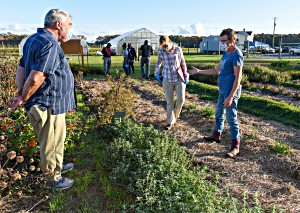
The theme from the 17th annual Small Farm Conference sums it up, “Remaining Resilient and Innovative.” Organizers rose to the pandemic-era challenge of shifting to a hybrid format per responses from a pre-event survey to provide an experience that met the needs of both in-person and virtual attendees.
“The uncertainty of the times combined with the many considerations on how to ensure the safety of attendees led to changes that we certainly never anticipated,” said Berran Rogers, coordinator of UMES Extension’s Small Farm Program and chair of the conference. “Nonetheless, with the efforts of everyone involved, it was impressive to see how everything came together for the benefit of our stakeholders.”
Field tours limited to 15 people per session on Friday, Nov. 6 offered participants an opportunity to visit the UMES Education and Demonstration Farm on Stewart Neck Road in Princess Anne, the Coops to Co-ops Farm on Peggy Neck Road and the UMES Sheep and Goat Farm.
UMES Extension’s alternative crop specialist Dr. Nadine Burton negotiated the myriad of demonstration plots and high tunnel greenhouses to show her audience specialty crops grown there, including hibiscus, turmeric, ginger and callaloo. She hopes to introduce them in the Delmarva cropping system.
The calyces of hibiscus plants, she explained, can be harvested and sold for about $15 to $20 per pound. Although labor intensive, the crop can be used not only for teas, but also for wine, beer and jams. Callaloo, a green leafy vegetable originating in the Caribbean, is high in iron and may be useful in controlling hypertension, while turmeric might relieve inflammation, she said. Other specialty crops like hibiscus and especially aronia berries, are antioxidant-rich.

“In addition to learning about the specialty crops we’re growing out at the farm, participants were impressed with how we’re helping farmers see the value-added opportunities associated with growing such crops,” Rogers said.
Also on the Demonstration Farm, specialty herbs consultant Henriette den Ouden, highlighted some 20 different specialty herbs, mostly medicinal herbs, but also some ethnic and culinary herbs. She discussed choices for starting material, pest management, harvest methods and estimates of time input and production.
“Participants are looking forward to additional workshops that allow for hands-on opportunities to learn more about specialty crops and herbs,” Rogers said. “In exit surveys, conference attendees found the presentations to be informative and the presenters knowledgeable.”

Another highlight of the first day of the conference according to Rogers was the farm tour stop at the Coops to Co-ops farmers market. The Co-op is a unique study in “how you can repurpose abandoned chicken houses into multi-use spaces that support agritourism, community farmers markets and controlled vegetable production opportunities.”
As part of Friday’s offerings, conference-goers also watched a vegetable fermentation demonstration and visited the Sheep and Goat Farm where Associate Administrator for UMES Extension Dr. E. Nelson Escobar shared his expertise as a small ruminant specialist.
Over 100 registrants took advantage of virtual sessions on Saturday. Some of the most popular topics were “Bio-Dynamic Farming Principles and Advantages,” “Financial Planning and Management Strategies in Uncertain Times,” and “Development of African Caribbean Specialty Crops.”
UMES’ Dr. Simon Zebelo, an associate professor of entomology and plant biology, and University of Maryland’s Dr. Cerruti Hook spoke during a webinar on “Weeds and Integrated Pest Management.” Hook suggested farmers alter their routine to combat weeds, such as varying crops, planting times, harvesting times and tillage methods. He pointed to quality seeds, planting more densely, cleaning equipment between fields and post-harvest care in fields as advantageous.
Zebelo, in turn, shared his integrated organic pest management practices involving the effect of trap crops on insect pests. As part of his research, he planted squash as a perimeter around test watermelon plots on UMES’ Agricultural Experiment Station and on Delmarva farmers’ fields in an effort to attract cucumber beetles. The results, he said, were that the beetles preferred the squash, the trap crop, allowing the watermelons to grow larger and more plentiful.
The virtual aspect of the conference, Rogers said, made it possible “to attract participants from across the country and as far away as Nigeria.” Conference registrants, he said, will also have the ability to view sessions for up to 60 days following the event.
Gail Stephens, agricultural communications and media associate, School of Agricultural and Natural Sciences, University of Maryland Eastern Shore, 410-621-3850, gcstephens@umes.edu.
Photos by Todd Dudek, agricultural communications, UMES Extension, tdudek@umes.edu.



